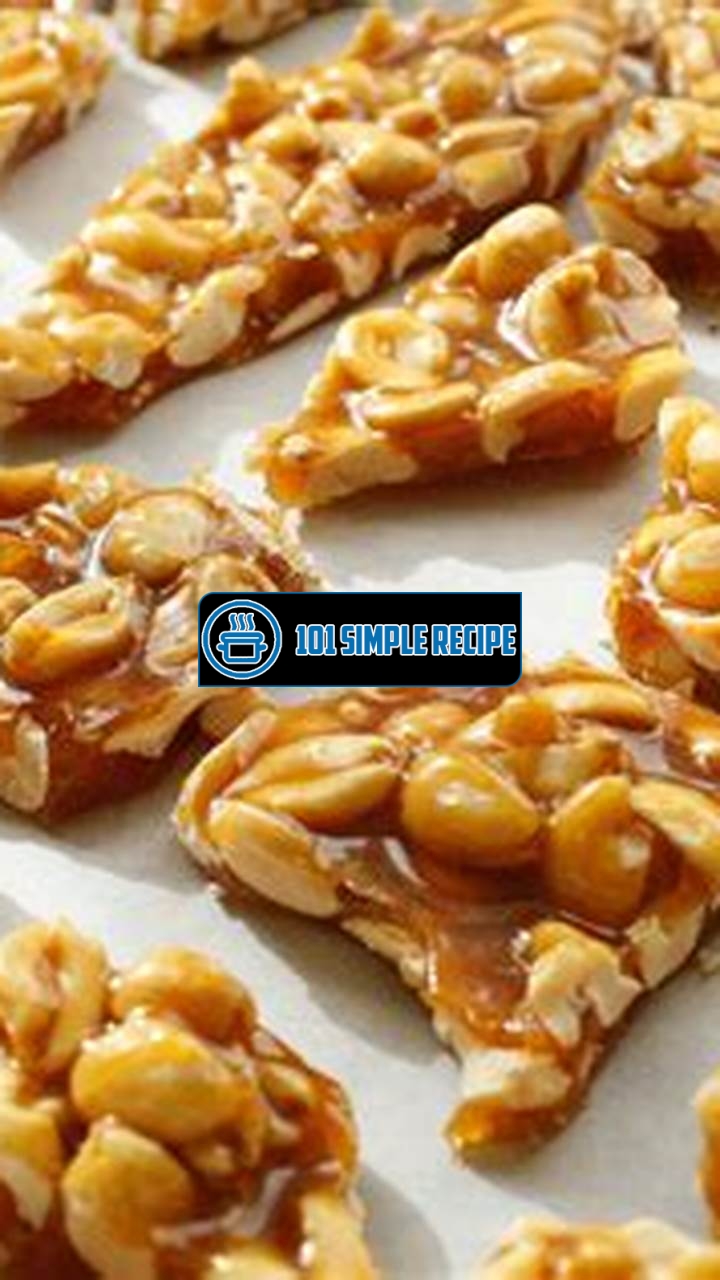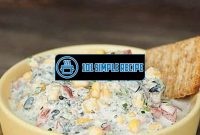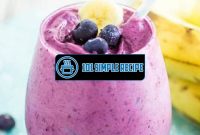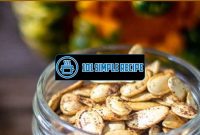Are you a fan of sweet treats but also conscious of your health? Then you might be wondering: is peanut brittle healthy? In this article, we will explore the nutritional benefits of this popular confectionery and shed light on whether it can fit into a balanced diet. So grab a cup of coffee ☕️ and let’s dig into the delectable world of peanut brittle.

The Nutritional Profile of Peanut Brittle
Peanut brittle is a popular snack made from a mixture of peanuts, sugar, and butter. While it may be a tasty treat, it is important to consider its nutritional profile before incorporating it into your diet. Let’s explore the key nutritional aspects of peanut brittle and how it can fit into a healthy eating plan.
One of the main nutritional components of peanut brittle is, as the name suggests. peanuts. Peanuts are a rich source of protein, healthy fats, and various vitamins and minerals. They are also high in fiber, which can promote feelings of fullness and aid in digestion. Including peanuts in your diet can be beneficial for overall health.
However, it’s worth noting that peanut brittle is not solely made up of peanuts. It also contains sugar and butter, which can significantly impact its nutritional value. The addition of sugar increases the calorie content of peanut brittle and may contribute to weight gain if consumed in excess.
Furthermore, consuming large amounts of added sugars can increase the risk of various health issues like obesity, type 2 diabetes, and heart disease. It is important to consume peanut brittle in moderation to avoid these potential negative effects.
In terms of fat content, peanut brittle is relatively high due to the presence of butter. While some fats are necessary for a balanced diet, it is crucial to be mindful of the type and amount of fat consumed. Too much saturated fat, which is primarily found in butter, can increase cholesterol levels and the risk of heart disease.
Despite these considerations, peanut brittle can still be enjoyed as an occasional treat. It can provide a satisfying crunch and a burst of flavor. To keep it within a healthy eating plan, it is advisable to consume small portions and make it a part of a well-balanced diet.
The Ingredients of Peanut Brittle
Peanut brittle is made primarily from three key ingredients: peanuts, sugar, and butter. Peanuts provide the base and are rich in protein, healthy fats, and various vitamins and minerals. They are an excellent source of vitamin E, niacin, folate, and manganese.
Sugar is added to peanut brittle to provide sweetness. However, it is important to note that consuming large amounts of sugar can have negative effects on health. It is advisable to consume peanut brittle in moderation to avoid excessive sugar intake.
Butter is used to bind the ingredients together and add richness to the flavor. It provides fat and contributes to the overall texture of the brittle. However, due to its high saturated fat content, it is recommended to limit butter consumption to maintain a healthy diet.
The Caloric Content of Peanut Brittle
Peanut brittle is a calorie-dense food due to its high sugar and fat content. A small serving of peanut brittle, typically about 1 ounce or 28 grams, can contain around 150-200 calories. This can vary depending on the specific brand and recipe.
It is important to consider portion sizes when consuming peanut brittle, especially if you are watching your calorie intake. Enjoying a small portion can satisfy your sweet tooth without contributing excessive calories to your diet.
The Nutrients Found in Peanut Brittle
While peanut brittle does contain peanuts, which are nutrient-rich, the presence of added sugar and butter reduces its overall nutritional value. However, it still provides some essential nutrients.
- Protein: Peanuts are a good source of plant-based protein, which is essential for building and repairing tissues.
- Fiber: Peanuts contain dietary fiber, which aids in digestion and helps maintain a healthy digestive system.
- Vitamins and Minerals: Peanuts are rich in various vitamins and minerals, including vitamin E, niacin, folate, and manganese.
While peanut brittle may not be the healthiest snack option, it can still be enjoyed in moderation as part of a balanced diet. It is important to be mindful of portion sizes and consider the overall sugar and fat content when incorporating it into your eating plan.
The Health Benefits of Peanuts
Peanuts are more than just a tasty snack. They offer a wide range of health benefits that make them a valuable addition to your diet. Whether enjoyed on their own or in the form of peanut brittle, peanuts can contribute to improved well-being. Let’s dive into the various advantages that come with consuming peanuts, including peanut brittle.
The Heart-Healthy Qualities of Peanuts
When it comes to heart health, peanuts truly shine. These small legumes are packed with monounsaturated and polyunsaturated fats, which are known as the “good” fats. These healthy fats can help lower bad cholesterol levels in your blood, reducing the risk of cardiovascular diseases like heart attacks and strokes. Consuming peanuts, including peanut brittle made with minimal added sugars, can contribute to a healthier heart.
- Peanuts are a rich source of resveratrol, the same antioxidant found in red wine. Resveratrol has been linked to a lower risk of heart disease.
- The monounsaturated fats in peanuts can help reduce inflammation, improving overall heart health.
- Peanuts also contain high levels of magnesium, an essential mineral that plays a crucial role in maintaining a healthy heart rhythm.
The Protein Power of Peanuts
Looking to boost your protein intake? Peanuts have got you covered. These legumes are an excellent plant-based source of protein, providing all nine essential amino acids your body needs. Incorporating peanuts, including peanut brittle, into your diet can help support muscle growth, repair, and overall functioning.
- Just a 1-ounce serving of peanuts contains approximately 7 grams of protein, making them a convenient and protein-rich snack.
- Protein is crucial for building and repairing tissues, producing enzymes and hormones, and supporting a healthy immune system.
- Peanuts are especially beneficial for individuals following a vegetarian or vegan lifestyle, as they offer a plant-based protein source.
The Nutrient-Rich Nature of Peanuts
Not only are peanuts a great source of heart-healthy fats and protein, but they also boast an impressive nutritional profile. These legumes are packed with various essential vitamins, minerals, and antioxidants that contribute to overall health and well-being.
- Peanuts are rich in vitamin E, a powerful antioxidant that protects cells from damage caused by free radicals.
- They also provide important minerals like magnesium, phosphorus, potassium, and zinc, which are essential for proper bodily functions.
- Peanuts contain high levels of fiber, promoting healthy digestion and contributing to feelings of fullness after meals.
- Additionally, peanuts are a natural source of folate, a B vitamin that plays a crucial role in cell growth and development.
In conclusion, peanuts, including peanut brittle, offer a range of health benefits. Their heart-healthy fats, protein power, and nutrient-rich nature make them a valuable addition to a balanced diet. So, next time you crave a delicious snack, consider reaching for a handful of peanuts or enjoying a delightful piece of peanut brittle.
The Potential Drawbacks of Peanut Brittle
When it comes to indulging in peanut brittle, there are a few factors that may limit its overall healthiness. While this delicious treat may be tempting to snack on, it’s important to consider these potential drawbacks before reaching for another piece.
The Sugar Content of Peanut Brittle
One of the main concerns with peanut brittle is its high sugar content. While the exact amount can vary depending on the recipe, most peanut brittle contains a significant amount of sugar. This can pose a problem for those who are watching their sugar intake or have conditions like diabetes. Excessive sugar consumption can lead to weight gain, increased risk of heart disease, and negatively impact overall health.
It is essential to be mindful of the sugar content in peanut brittle, especially for individuals with certain dietary restrictions or health conditions.
The Impact on Dental Health
Another factor to consider is the impact of peanut brittle on dental health. The sticky nature of peanut brittle can cling to the teeth, promoting the growth of harmful bacteria and increasing the risk of cavities and tooth decay. Additionally, the high sugar content can contribute to the erosion of tooth enamel, further compromising dental health.
Regular consumption of peanut brittle without proper dental care can lead to dental issues, causing discomfort and potentially requiring dental treatment.
The Risk for Allergic Reactions
For individuals with peanut allergies, indulging in peanut brittle can pose a significant risk. Peanut allergies can range from mild to severe and can lead to symptoms such as itching, hives, difficulty breathing, and even anaphylaxis, a life-threatening allergic reaction. It is crucial for those with peanut allergies to avoid peanut brittle and any other products containing peanuts to prevent potentially dangerous allergic reactions.
Individuals with peanut allergies should exercise extreme caution and avoid consuming peanut brittle altogether to protect their health and well-being. ⚠️
Overall, while peanut brittle may be tasty and enjoyable, it is vital to be aware of the potential drawbacks. The high sugar content, impact on dental health, and risk for allergic reactions should all be considered before indulging in this popular treat. Moderation and mindful consumption are key to maintaining a healthy lifestyle while still enjoying occasional treats like peanut brittle.
Making Healthier Choices with Peanut Brittle
When it comes to indulging in a sweet treat, peanut brittle is a popular choice. However, it is important to consider healthier alternatives and practice portion control in order to enjoy this treat without compromising your health. By making mindful choices, you can still satisfy your craving for peanut brittle while reaping its nutritional benefits.
Choosing Peanut Brittle with Less Added Sugar
In order to make a healthier choice when it comes to peanut brittle, it is essential to look for options that have less added sugar. Excessive sugar consumption can lead to various health issues such as weight gain, diabetes, and heart disease. Therefore, opt for brands or recipes that use natural sweeteners like honey or maple syrup instead of refined sugar.
Additionally, read the labels carefully to ensure that the peanut brittle you choose does not contain high-fructose corn syrup or other artificial sweeteners. These additives can have negative effects on your health and contribute to inflammation in the body.
Combining Peanut Brittle with Nutritious Foods
While enjoying peanut brittle, it is important to balance it out with nutritious foods to ensure that you are getting a well-rounded diet. Consider incorporating fruits, such as sliced apples or bananas, alongside your peanut brittle. These fruits not only add natural sweetness but also provide essential vitamins, minerals, and fiber.
Another way to enhance the nutritional value of your peanut brittle is by adding a handful of nuts or seeds. This can provide an extra dose of protein, healthy fats, and antioxidants. You can also sprinkle some chia seeds or flaxseeds on top of your peanut brittle for an added nutritional boost.
Practicing Moderation with Peanut Brittle Consumption
While peanut brittle may offer some nutritional benefits, it is still important to practice moderation when consuming this treat. Peanut brittle is calorie-dense and can lead to weight gain if consumed in excess. Therefore, be mindful of your portion sizes and limit your intake to a small serving.
Consider breaking your peanut brittle into smaller pieces and portioning them out into small bags or containers. This can help you control your portion sizes and prevent mindless snacking. It is also important to savor each bite and enjoy the flavors and textures of the peanut brittle rather than mindlessly munching.
Remember, moderation is key in maintaining a healthy diet and lifestyle. By practicing portion control and making mindful choices, you can enjoy peanut brittle without feeling guilty or compromising your health.
Note: Always consult with a healthcare professional or a registered dietitian before making any significant changes to your diet, especially if you have any underlying health conditions or dietary restrictions.
Incorporating Peanut Brittle into a Balanced Diet
Do you love the taste and crunch of peanut brittle but wonder if it can be a part of a healthy diet? The good news is that incorporating peanut brittle into a well-rounded diet is possible without compromising your overall health. By considering portion sizes, pairing peanut brittle with other nutrient-dense foods, and listening to your body’s cues, you can enjoy this sweet treat guilt-free.
Considering Portion Sizes
When it comes to enjoying peanut brittle, portion control is key. While it may be tempting to indulge in large amounts, it’s important to be mindful of your serving size. A recommended portion of peanut brittle is typically around one ounce, which is equivalent to a small handful or about half a cup. By sticking to this recommended serving size, you can satisfy your cravings without overindulging.
Tip: Use measuring cups or a food scale to accurately portion out your peanut brittle and avoid mindless snacking.
Pairing Peanut Brittle with Other Nutrient-Dense Foods
One way to incorporate peanut brittle into a balanced diet is by pairing it with other nutrient-dense foods. Since peanut brittle is primarily made of peanuts, which are a good source of protein and healthy fats, you can enhance its nutritional value by combining it with other nutritious options. For example, enjoying peanut brittle alongside a handful of almonds or a serving of Greek yogurt can provide additional protein and healthy fats, creating a more well-rounded snack or dessert.
Tip: Add some sliced bananas or berries to your peanut brittle and yogurt for extra fiber and vitamins.
Listening to Your Body’s Cues
While it’s important to be mindful of portion sizes and make nutritious pairings, it’s equally crucial to listen to your body’s cues. Pay attention to how your body feels after eating peanut brittle. Does it leave you satisfied and energized, or do you feel sluggish and craving for more? Being aware of how your body reacts to certain foods will help you make informed decisions about your diet.
Tip: If you notice that peanut brittle leaves you feeling unsatisfied or craving for more, try incorporating it into your diet less frequently or in smaller amounts.
In conclusion, peanut brittle can be a part of a healthy diet when consumed in moderation and paired with nutrient-dense foods. By considering portion sizes, making smart food combinations, and listening to your body’s cues, you can enjoy the sweet and crunchy goodness of peanut brittle while maintaining overall health.
Thank you for taking the time to read our article on whether peanut brittle is healthy. We hope you found it informative and helpful in making decisions about your diet. Remember, while peanut brittle can be a tasty treat, it should be consumed in moderation due to its high sugar and calorie content. If you have any more questions or need further information, please don’t hesitate to reach out. We look forward to seeing you again soon!
Frequently Asked Questions
Here are some common questions about peanut brittle:
| No. | Questions | Answers |
|---|---|---|
| 1. | Is peanut brittle a healthy snack option? | Peanut brittle, while being a tasty treat, is not considered a healthy snack option due to its high sugar and calorie content. However, it can still be enjoyed in moderation as an occasional indulgence. |
| 2. | Does peanut brittle contain any nutritional benefits? | Peanut brittle does contain peanuts, which are a good source of protein and healthy fats. However, the high sugar and calorie content in peanut brittle outweigh the nutritional benefits of peanuts. |
| 3. | Are there any alternatives to traditional peanut brittle? | Yes, there are healthier alternatives to traditional peanut brittle, such as homemade versions with less sugar and added nuts or seeds for extra nutrition. You can also try other nut brittle recipes using almonds, cashews, or pistachios. |
| 4. | Can peanut brittle be part of a balanced diet? | While peanut brittle should not be a regular part of a balanced diet, it can be enjoyed occasionally as a treat. It’s important to balance indulgences like peanut brittle with a variety of nutrient-rich foods. |
| 5. | Is there a healthier alternative to sugar in peanut brittle? | Yes, you can try using natural sweeteners like honey or maple syrup instead of refined sugar in homemade peanut brittle recipes. These alternatives may provide some additional nutrients and have a lower glycemic index. |
| 6. | What are some other nut-based snacks that are healthier than peanut brittle? | There are several healthier nut-based snacks you can try, such as roasted almonds, cashew butter on whole wheat crackers, or homemade trail mix with a variety of nuts and dried fruits. |
Thank You for Reading!
We hope this article has shed some light on the question of whether peanut brittle is healthy. Remember to enjoy peanut brittle in moderation as an occasional treat, and explore healthier alternatives if you’re looking for a more nutritious option. Please visit our site again for more informative articles on nutrition and healthy living.
Jump to Recipe
Peanut Brittle Recipe
Learn how to make delicious peanut brittle at home with this easy recipe.
- 1 cup granulated sugar
- 1/2 cup light corn syrup
- 1/4 cup water
- 1 cup roasted peanuts
- 1 tablespoon unsalted butter
- 1 teaspoon vanilla extract
- 1 teaspoon baking soda
- Gather all the ingredients needed for the peanut brittle recipe. Line a baking sheet with parchment paper and set it aside.
- In a large saucepan, combine the sugar, corn syrup, and water. Heat over medium-high heat, stirring constantly, until the mixture comes to a boil.
- Once the sugar syrup reaches a boil, stir in the roasted peanuts. Continue to cook and stir until the mixture reaches a temperature of 300°F (150°C) on a candy thermometer.
- Remove the saucepan from heat and quickly stir in the butter and vanilla extract until well combined.
- Add the baking soda to the saucepan and stir quickly. The mixture will foam up.
- Pour the foamy mixture onto the prepared baking sheet, spreading it out with a spatula or the back of a spoon.
- Allow the peanut brittle to cool completely, then break it into smaller pieces. Store in an airtight container.






